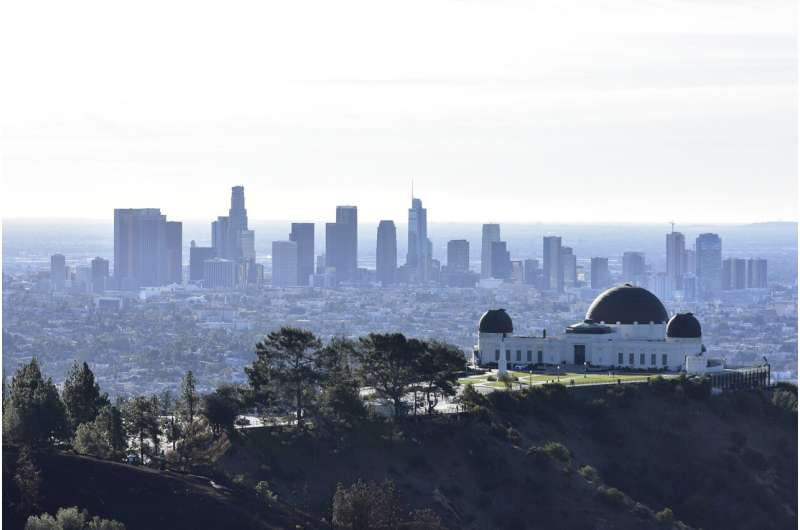This article has been reviewed according to Science X's editorial process and policies. Editors have highlighted the following attributes while ensuring the content's credibility:
fact-checked
trusted source
proofread
Community-driven analysis identifies strategies to improve equity in Los Angeles' clean energy transition

After two years of robust modeling and gathering input from over 100 community members, 14 community-based organizations, and 31 additional stakeholder organizations in Los Angeles, the U.S. Department of Energy's National Renewable Energy Laboratory (NREL) has synthesized its findings into equitable clean energy transition strategies for the city.
While NREL's original groundbreaking Los Angeles 100% Renewable Energy (LA100) study in 2021—commissioned by the city of Los Angeles' Department of Water and Power (LADWP)—found that all communities in Los Angeles will share in the environmental and public health benefits of the clean energy transition, it also emphasized that improving equitable participation and outcomes for every resident requires intentionally designed policies and programs. LA100 Equity Strategies answers that call.
NREL used procedural, recognition, and distributional justice tenets to guide its engagement with Los Angeles stakeholders and analysis approaches. In partnership with LADWP and the University of California, Los Angeles (UCLA), the project identified community-informed approaches that Los Angeles can take to help ensure every Angeleno participates in and benefits from the clean energy transition—approaches that are now in the LA100 Equity Strategies project report.
"This project was driven by the voices of the people of Los Angeles," said Kate Anderson, NREL strategy lead and project lead for LA100 Equity Strategies. "We knew that for these strategies to be successful, we needed to tailor them to the needs of the community. The challenges and goals that they shared with us shaped this project."
A steering committee composed of leaders from 14 community-based organizations met monthly to provide guidance and facilitate listening sessions with their community members.
Through these listening sessions, the project team identified five priority areas to guide the resulting equity strategies:
- Inclusive community involvement
- Affordability and burdens
- Access to and use of energy technologies, programs, and infrastructure
- Health, safety, and community resilience
- Jobs and workforce development.
The team synthesized this community guidance with research on current and past inequities and extensive modeling and analysis, including detailed modeling of 50,000 representative Los Angeles homes across different housing types, efficiency levels, and climate zones.
"Our community engagement, modeling, and analysis all had to work in tandem," Anderson said. "Each piece was crucial to identifying tangible, actionable strategies that could improve equity in the city's clean energy transition."
The project results find that historical LADWP program investments are inequitable. For example, only 23% of electric vehicle incentives and 38% of solar incentives went to disadvantaged communities, who make up 49% of the city population. A 100% clean energy transition calls for a major shift in how investments are allocated. This includes focusing investments on resources that all households can access like shared solar, public charging stations, and electrification of school buses, transit buses, and the city fleet, rather than net metered rooftop solar or personally owned electric vehicles, which primarily benefit wealthier households.
In the face of increasing heat waves, 230,000 low-income households are projected to experience more than two months of exposure to dangerous indoor air temperatures annually by 2035. Ensuring safe temperatures for LA's residents involves a particular focus on providing cooling to low-income multifamily-building residents, who are at the highest risk.
The resulting strategies expand the activities and programs that are already working in Los Angeles and add new approaches to improve community engagement, strategic technology and infrastructure investments, and the design of new programs and policies. Cost-benefit trade-offs and metrics to inform implementation and evaluation are also included.
The NREL team also categorized the strategies by ease of implementation, impact, and prerequisites for long-term success. Some strategies are ready to be implemented immediately, while others may require several years to bring to fruition and require action from various agencies across Los Angeles.
Though the LA100 Equity Strategies project is specific to Los Angeles, its equity-based principles and research methodologies can serve as a blueprint for other utilities and metropolitan areas pursuing their own ambitious, equitable clean energy goals.
More information: LA100 Equity Strategies. www.nrel.gov/docs/fy24osti/85960.pdf
Provided by National Renewable Energy Laboratory





















